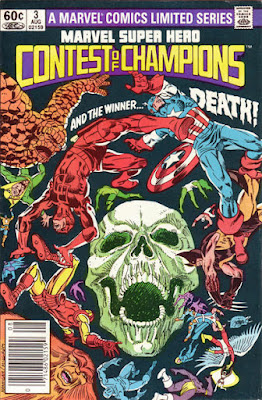Holy smoke! What is this? I could have sworn I'd reviewed the first appearance of every great Silver Age Marvel Hero - and Ant-Man - but I've suddenly realised I've never cast a critical eye over the arrival of the Hulk.
Does my having forgotten to tackle it say something about the quality of the comic?
Or does it just say something about the quality of me?
Here's where we find out!
It's a great day for US atomic scientist Bruce Banner who's due to detonate his Gamma Bomb, a weapon that could destroy a continent and whose other possible effects he's not really too sure about. But, whatever, they are, he's about to find out.
Fortunately, his assistant - a communist saboteur cunningly hiding behind the name "Igor" - is there to try and talk him out of it, on the grounds that he could kill everybody.
Bruce, however, is having none of it. He's got a bomb to detonate and, by George, he's going to do it. He even points out to the Russian saboteur he's hired as his assistant that he doesn't make mistakes.
Fortunately, Bruce isn't the only one in an explodey mood because that's when his boss General Thunderbolt Ross barges in and demands he sets the thing off immediately because he's bored with waiting!
It's a strange thing when a Red Menace story forces you to start siding with the communist.
But, sadly, for Bruce, there's something even worse than socialism on the loose.
And that's a teenager!
It's true. Rick Jones has decided it'll be top lulz to park his car in the middle of the test site and start playing his mouth organ.
Clearly no lover of music, Banner rushes to the scene to get Rick out of there but, just as he's doing so, Igor decides it's the perfect moment to set off the bomb and kill his superior.
And that's the end for Bruce Banner.
Except it isn't - because, somehow, he survives and, that night, as he chats in his hospital cell, with Rick, he turns into a creature called the Hulk and starts to knock down walls before turning back into Bruce, the moment the sun returns.
But such a rampage cannot go unnoticed.
And so it is that, in an unnamed communist country, news of the Hulk has reached the ears of a huge-headed radiation-mutated genius called the Gargoyle who decides to fly to America to kidnap the brute.
By some unknown means, he lands his plane where the Hulk just happens to be and abducts both the monster and Rick Jones, taking them back to his homeland.
But, there, he starts crying and declares that he wishes he could be a normal man again.
Bruce responds by promising to use his knowledge of radiation to cure him and, having done so, flees the country, in a stolen rocket, while the man who'd been the Gargoyle blows up the facility where he works, to gain revenge upon his employers.
And, with that, the first adventure of the Hulk is over!
Except it's not really, because the Hulk doesn't actually have an adventure. He's barely in the story and it's Bruce Banner who saves the day.
The thing that most leaps out at me is that this origin doesn't have the moral element of many of Marvel's Silver Age debuts. Bruce has been the architect of his own downfall - and completely irresponsible in creating a possibly continent-destroying bomb - but, at the tale's end, he doesn't show any indication of having learnt anything from it. There are no signs of him being a reformed character, of him grasping that his fate is his own fault, or even of him having decided he must use his powers for good.
When it comes to the bad guy, the Gargoyle's a fairly undeveloped villain who also barely appears and is quickly disposed of. Clearly, though, Stan and Jack liked his basic concept enough to return to it with the far more motivated Leader.
However, despite the Gargoyle's throwaway nature, the basic theme of two men transformed by nuclear tests - one through his own foolishness, and the other through that of his government - where one gains release and the other's doomed to be trapped forever in his nightmare, displays a pleasing symmetry. Or at least it would if the Gargoyle featured more prominently in the tale.
But, of course, we can't ignore the elephant in the room. And that's skin colour. Famously, the jade giant isn't green in this story. He's grey.
Except on the splash page, where he's purple.
And page eight where he's flesh-coloured.
And page nine where he's red.
And page ten where he's yellow.
And page eighteen where he's green.
In fairness, he's not the only character who keeps changing colour. So does the Gargoyle which, I suppose, does serve to further highlight the parallels between the two characters.
It's easy to talk about 1960s Marvel as a creative whirlwind, flinging innovation at us from all directions but the truth is Lee and Kirby were beating deadlines by mostly recycling well-worn tropes and, here, the roots of the strip are clear, drawing heavily on such familiar characters as the Wolfman, Frankenstein and Dr Jekyll. The Hulk also has a clear debt to Marvel's own Thing whose early appearances in the Fantastic Four had him displaying similar anti-social tendencies.
 |
Did we all see what Stan and Jack did there? Banner is doomed to become the very thing he detests most. |
But the strongest influence is, surely, 1950s radiation movies. With its atom bombs, reckless scientists, lovestruck heroines, hip teenagers, Cold War politics, spies and blustering military types, it genuinely does feel like an adaptation of a 1950s movie that was never made. It really only deviates from that mode in its very final act where it suddenly moves off in its own direction entirely.
So, the exciting core concept of a scientist who turns into a destructive brute is set up.
But, then again, just how exciting is it?
As mentioned earlier, the Hulk barely appears in the tale, the human drama of Bruce Banner's torment and his conflicts and interactions with those around him clearly being of more interest to Lee and Kirby than the limited spectacle of a muscleman walking around bending things.
And, when it comes to resolutions, Banner solving things with his intellect is always going to be more compelling than the Hulk just smashing things.
At least, that's how it seems at this stage. Later stories would demonstrate just how much fun the Hulk solving problems by smashing them could be. But that would come later. Exactly how to handle the Hulk's strip is a thing the title's various writers and artists would struggle with for years to come.
Rather more promisingly, the concept of a teenage boy, a tortured scientist and a monster bound together by fate is a potentially compelling one, even if it rarely proved compelling in practice.











































